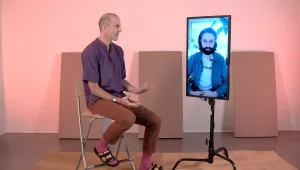Sarah Brin, an accomplished writer and curator, explores the intricate relationship between art, technology, and community. Brin highlights her experience as a public programs manager at Autodesk’s Pier 9 Workshop, emphasizing its significance as a hub for various discussed projects. She expresses a deep interest in “art that happens in the corner”—art that operates outside traditional institutions and engages underrepresented demographics.
Brin shares her concerns about how, in the realm of digital fabrication and tech-integrated art, form often overshadows personal experience and context. She uses examples like biased AI in Google image searches and the initial racial recognition issues with Microsoft Kinect to illustrate how digital systems can perpetuate human biases. Moreover, she emphasizes the importance of safe spaces and community guidelines to foster inclusivity and prevent harm in diverse environments.
A central theme of Brin’s talk is the potential of digital tools for both creative and destructive ends, a dichotomy she explores with a critical yet optimistic lens. She highlights projects like Project Enable, which uses 3D printing to create prosthetic limbs for children, showcasing how technology can significantly improve lives. Additionally, Brin ponders the aesthetic and communicative possibilities of digital fabrication, referencing scholars like Ian Bogost to discuss how different media influence our understanding and interactions with the world.
Overall, Brin’s discourse is a rich exploration of how digital and physical realms intersect, focusing on the transformative power of community and technology in the arts.
This presentation was part of the symposium Unhanded. In this panel we ask about the variety of new relationships with materials that emerging with the increasing ubiquitousness of digital technologies. With the increased complexity of tools we wonder how do we learn about materials? How do we get to know them? How do we share this knowledge? We can now know the molecular structure of wood or metal without touching it. Is this a more intimate relationship than working directly with our hands? Does it matter? If the objects coming out of digital and mechanical processes are more removed from our handywork, how might they carry the mark of the machine? Should we be able to read the machine in the material?
Sarah Brin specializes in creative partnerships for technology, games, and entertainment. Her projects are known for their visual appeal, playfulness, and broad audience reach.
Professionally, Sarah has extensive experience in building and leading teams that create unprecedented creative technology experiences. She is also skilled in designing processes and programs for organizations undergoing rapid growth. She resides in London with her big dog, Svenska.
Sarah’s projects consistently demonstrate creativity that excites the public and sparks a desire to learn more. She has developed and led joint ventures and partnerships for prestigious brands such as Sony PlayStation, Rolls Royce, Autodesk, Meow Wolf, the European Union, Microsoft, BBC, Aardman Animation, SFMOMA, Google, and many others. One of her aspirations is to develop creative partnerships for A24 and/or David Byrne.
Her work has earned her a BAFTA nomination and awards from Creative Producers International, Red Dot, and the International Game Developers Association.
As long as there's technological innovation for growth and creativity, there will continue to be technological advances and tools for destruction and war
I do a lot of work with with art and technology, and I’m very, very interested in work that happens in the corner. So that might mean working outside of traditional arts institutions or working with folks who aren’t necessarily catered to or target demographics for fields like tech or even traditional arts institutions. I spoke earlier in the week at Carleton, and I’m going to try to not be too redundant to what I said over there, but basically I shared an anxiety I have about how I often find that, especially in the realms of digital fabrication, but also art made with technology in general is that form tends to dwarf personal experience and context, and that makes me nervous. So I this is a image of our water jet cutter. So we’re connected. We have things in common and at this watershed over at nine. And so so I want to talk about this. You also spoke about Plato, which I thought was really relevant. You folks have human beings have always had utopian tendencies. And I think when we think about technology, it’s really hard to not be utopian when we think about how technology can improve our life, because it has it has most certainly, you know, vaccines, refrigeration, all that stuff. As long as there’s technological innovation for growth and creativity, there will continue to be technological advances and tools for destruction and war. So on that positive note, I want to I want to dig in to the prompts that Ryan Ryan shared with us for this presentation. So it starts with the world. Inside the computer is one built on rules that we have written. The world outside is more complicated and largely out of our control. So, okay, so I would say that part of that is for sure. True. You know, we we do build the world inside the computer and subsequently that means the world inside the computers has bias just like we do. We see that bias articulated in systems here is just this is more work being done in your mind that yeah, that’s a good one. So some of these examples of biases include how if you look at this was recently corrected, if you look at Google image searches for black folks, you see them tag as gorillas. Or if you look at when the Microsoft Kinect was first launched, it had problems doing facial recognition detection for for folks who were not white, Caucasian. So those are just some of the examples in which human biases get articulated into digital spaces. And so I also want to talk about the world that is purportedly out of our control. So something really exciting about makers is that, you know, there’s this kind of entrepreneurial, individual spirit of discovery and invention that we see in in maker culture, but also it’s extremely, extremely dependent and rooted in community. So all you folks who are in here today, I have reason to believe that you are in one way attached to a specific community, whether it is a university or a makerspace or an arts institution. So we are all cultural producers as Ramco. Well, I want to talk about the idea of cultural production as as Remco mentioned earlier in the day. So, okay, I want to talk about our role in cultural production, especially specifically as it pertains to digital culture and making So and one thing that I want to talk about is this idea of of safe spaces and so this might be a term some of you have heard before, and this might be a new term for some of you. Basically when you’re working within a community, some communities have what are called safe space policies, and that’s a shared set of values and guidelines for that community to agree upon. And of course, when you have a community of smart adults, as I think of most of you and not all of you are, I should also. So I think so I’m getting good vibes.
I mentioned diverse spaces and innovative space. Why? Why do I think that? And that’s because of the phosphor logic that can Shine spoke a lot about how language frames organized thought. And so I think that’s that’s pretty true. And I think language frames our relationship to disciplines. So for an example, we know what a horse is and we know what I rhinoceroses and subsequently because we have these two bodies of knowledge about what these two individual things are, we can imagine what a unicorn will be. So subsequently, I believe if we want innovation in our fields, whether it’s innovation for a product or social innovation or technological innovation, we need to combine fields and we need to combine spirit experiences. And when we draw experience from only a specific group of folks, I think we’re really limited of eliminating a lot of potential. So, okay, so that’s that’s me. On Diversity and Safe Spaces. yeah, this is a great project. This is this is Anne Robinson, and he created this hand in collaboration with an artist named Koby Unger. And actually this is really relevant to the next question in the prompt, which is what kinds of errors and opportunities arise when these two worlds meet the digital and the physical. So one of these I opportunities is collaboration. So this is not an example of project enable, but what project Enable is it’s a really, really cool group that designs and 3D prints, prosthetic hands for kids who don’t have them. And 3D printing and prosthetics is actually one of the most exciting part of parts of 3D printing for me because I you know, there’s a lot of a lot of those Yoda heads out there in the world. If you, you know, you can get a hand that’s arguably pretty good. And so something that’s also really cool about 3D printing prosthetics is that kids grow all the time. Traditional prosthetics are extremely expensive. If you heat up the material and these prosthetics, you can kind of grow the prosthetic along with a kid for a while, which is, I think, really, really exciting. Subsequently, it also means collaboration. So, you know, Instructables, which is a how to website, is part of Autodesk. And so if you look at Instructables, there are how to instructions for do for doing all kinds of projects, including this arm for Aiden and he requested a Lego attachment. So that’s what you’re seeing there. And there’s also one for playing the violin. Violin and the Nintendo Wii. So, so you also, you know, we see folks who are struggling with technical problems and you have people from all over the world contributing feedback and helping each other, I think is just super, super, super, super cool. And so the last two questions in the prompt. Yeah, this is bananas for me. I think bananas is work is is really, really, really gorgeous. This is part of why I get really concerned about form and experience because this is a beautiful, beautiful object, but I have anxieties about it. And this is John and Mark also really, really exciting project. Yeah. Okay. So, so the last two questions are about esthetics. So what kinds of errors and opportunities arise when, sorry, is a new esthetic always bound up in exploration of algorithms, or is there something else that can happen?

What does it mean to speak of “aural culture?” What does listening offer, as a tool or technique for understanding our world, that visual perception cannot? The sounds that fill our lives are dense with information about the interwoven cultures to which we belong, and approaches to their investigation can take similarly varied routes. For Linda-Ruth Salter, language is a primary element of culture. Expressed aloud it is a richly coded meaning system, but it can also speak volumes when forced into silence.

From NFTs to governance structures, blockchain technology may be a glimpse into the future. At least that is what Jesse McKee and the team at 221A are exploring. In this conversation McKee shares a bit about the history of artist-run centres in Canada, the limitless potential for blockchain to change how society is ordered, and the rise of decentralized autonomous organizations (DAOs). Listen closely to discover the literary Easter eggs Jesse drops that are framing research at 221A.